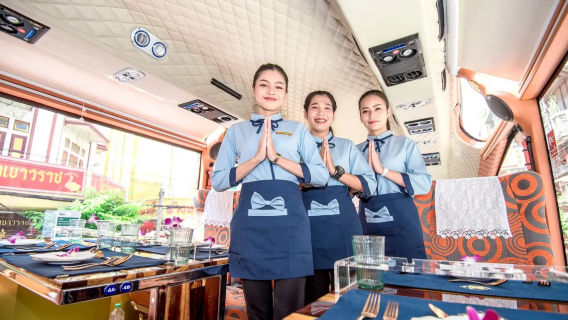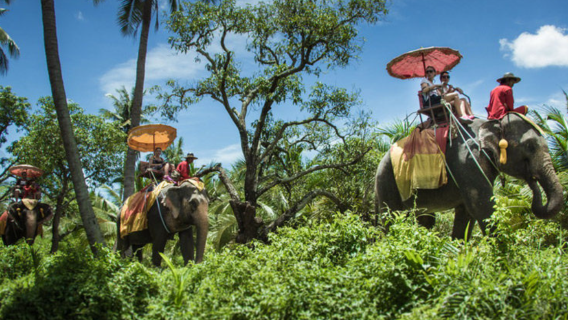
So, you’re heading to Bangkok and wondering how to get around efficiently?
Forget about sitting in traffic for hours as Bangkok’s train system is your best bet. As a Singaporean used to our super-efficient MRT, Bangkok’s trains will feel familiar yet different in some ways.
Let me break it down for you in this Bangkok train guide so you can zip around like a pro.
Understanding the Bangkok Train Map
Unlike Singapore, where we have a single MRT system covering the entire island, Bangkok’s train network is made up of multiple systems operated by different entities.
While this might sound confusing at first, navigating the city becomes effortless once you understand what this Bangkok train guide covers.
Now, when people say “Bangkok Train Map”, they’re usually referring to multiple rail networks, not just one system like our MRT.

Source: Wikipedia
There are four main train networks that visitors typically use:
BTS Skytrain (Green Line) – The most popular and tourist-friendly system, perfect for getting around shopping and entertainment areas.
MRT (Blue, Purple, Yellow & Pink Lines) – A combination of subway and monorail lines that extend beyond central Bangkok, covering cultural sites, suburban districts, and residential areas.
Airport Rail Link (ARL - Red Line) – The fastest and cheapest way to get from Suvarnabhumi Airport to central Bangkok.
SRT Red Line (Commuter Train) – A less touristy but useful option, especially for those heading to Don Mueang Airport or further outside the city.
Each of these networks operates independently, meaning different tickets or cards are required for each.
However, Bangkok has been working towards better integration, and options like contactless payments on MRT and the Rabbit Card for BTS make things much easier.
Top Things To do In Bangkok
BTS Skytrain (Bangkok Mass Transit System - Green Lines)

Source: Wikipedia
The BTS Skytrain is Bangkok’s most popular and convenient train system, especially for tourists.
It’s an elevated train system, similar to our MRT but running above ground. This makes it perfect for avoiding Bangkok’s notorious traffic.
If you're unsure which BTS station is closest to your destination, a Bangkok BTS map will help you figure out the best route in seconds.
| Detail | Information |
| Operating Hours | 6:00 AM – Midnight daily |
| Pricing | Starts at 16 THB (~SGD 0.60), up to 59 THB (~SGD 2.50) depending on the distance |
| Payment | You can use single-trip tickets or get a Rabbit Card (similar to our EZ-Link) |
Notable Stations
Siam (Interchange Station) – The heart of Bangkok’s shopping district (Siam Paragon, MBK, CentralWorld). If you love shopping, allocate at least half a day here. Trust me, you’ll need it!
Asok – Connected to Sukhumvit MRT and home to Terminal 21. The food court at Terminal 21 is a hidden gem! Affordable, delicious Thai street food in an air-conditioned space. This is perfect after a long day of walking.
Chit Lom – Easy access to Erawan Shrine and Pratunam shopping area. If you’re planning to visit Erawan Shrine, go early in the morning to avoid the crowd.
Mo Chit – Best for Chatuchak Weekend Market. Here’s a good tip for shoppers: Arrive by 10 AM before it gets too hot and overwhelming.
MRT (Mass Rapid Transit - Blue, Purple, Yellow & Pink Lines)

Source: Wikipedia
Unlike the BTS, the MRT runs underground and covers areas the Skytrain doesn’t reach, like Chinatown and the Old City. If you’re heading to cultural sites, this will be your best bet.
For tourists, the Blue and Purple Lines are the most useful, while the Yellow and Pink Lines primarily serve local commuters.
Here's what you need to know:
- MRT Blue Line – The main loop connecting major tourist areas, including Chinatown, Sukhumvit, and Chatuchak.
- MRT Purple Line – Extends northwest to Nonthaburi, primarily serving locals but useful for reaching less-touristy areas.
- MRT Yellow Line – A monorail running east-west, connecting Lat Phrao to Samrong, improving access to suburban Bangkok.
- MRT Pink Line – A new monorail (expected full operation in 2024) running north-south, linking Nonthaburi and Min Buri. While useful for locals, it’s less relevant for tourists.
Do note that unlike the BTS, the MRT doesn’t use the Rabbit Card, so you’ll need to buy an MRT card separately.
I found this out the hard way after topping up my Rabbit Card only to realize I couldn’t use it for the MRT! On the bright side, contactless credit or debit cards work on the MRT, so you can skip the ticket queue.
| Detail | Information |
| Operating Hours | 6:00 AM – Midnight daily |
| Pricing | Starts at 17 THB (~SGD 0.65), up to 43 THB (~SGD 1.70) |
| Payment | Single-trip tokens or MRT card (separate from Rabbit Card) |
Now, as the MRT has fewer interchange stations with the BTS, it’s worth having an MRT Bangkok map handy, especially if you're new to the system.
Notable Stations
A quick glance at an MRT Bangkok Map will show you that stations like Sam Yot and Sanam Chai provide easy access to Bangkok’s cultural gems.
Hua Lamphong (Blue Line) – Bangkok’s main train station for intercity travel. If you're planning to take a train to Ayutthaya, this is your starting point.
Sam Yot (Blue Line) – Closest to Chinatown (Yaowarat Road, Michelin-star street food!). ✅ Tip for travellers: Go in the evening when the neon lights and bustling street food stalls make the area come alive!
Sanam Chai (Blue Line) – Stunning station near the Grand Palace and Wat Pho. The station itself is gorgeous and it feels like stepping into a palace!
Chatuchak Park (Blue Line) – Alternative route to Chatuchak Weekend Market. If Mo Chit BTS is too crowded, try using this station instead.
Airport Rail Link (ARL - Red Line)

Source: Wikipedia
The fastest and cheapest way to get from Suvarnabhumi Airport to Bangkok is the Airport Rail Link to Phaya Thai station, where you can switch to the BTS for further travel.
| Detail | Information |
| Operating Hours | 5:30 AM – Midnight |
| Pricing | 15-45 THB (~SGD 0.60-1.80) depending on distance |
| Payment | Single-trip tokens or stored-value card |
Notable Stations
Makkasan (Interchange with MRT Phetchaburi) – A key interchange for those coming from Suvarnabhumi Airport. It connects to the MRT Phetchaburi station via a short walkway, providing quick access to Sukhumvit.
If you're staying in areas like Asok or Nana, this is a great station to switch lines and avoid the city's infamous traffic.
Phaya Thai (Interchange with BTS) – The final stop on the Airport Rail Link and the easiest way to transfer to the BTS Sukhumvit Line.
If your hotel is near a BTS station, this is the best point to switch from the airport train. You can skip Bangkok’s unpredictable taxi queues, especially during rush hour.
Recommended Hotels in Bangkok
SRT Red Line (Commuter Train)
The SRT Red Line is a commuter train system primarily used by locals, but it can be a great option for travellers heading to Don Mueang Airport or areas outside central Bangkok.
Unlike the BTS and MRT, the SRT Red Line is designed for intercity travel, making it less crowded with tourists but highly efficient for reaching northern districts.
| Detail | Information |
| Operating Hours | 5:30 AM – 11:00 PM |
| Pricing | Starts at 12 THB (~SGD 0.50), varies based on distance |
| Payment | Single-trip tickets (no Rabbit Card integration) |
Notable Stations
Bang Sue Grand Station – Bangkok’s largest railway hub, connecting to the MRT Blue Line for easy access to the city.
Don Mueang Station – The best way to reach Don Mueang Airport without dealing with road traffic.
Must-Know Bangkok Train Map Hacks

Source: Wikipedia
✅ Budget Mode for Travel - One of the best things about Bangkok’s public transport system is its affordability. Bangkok train ticket prices start as low as 16 THB, making it a budget-friendly way to get around. Check Bangkok train ticket prices in advance to help you plan your transport expenses more efficiently.
✅ Use Google Maps for Route Planning – Bangkok’s train system has multiple operators, so Google Maps is your best friend for planning the fastest route.
✅ Avoid Ticket Queues with the Rabbit Card & MRT Card – Get both to avoid long queues, or use a contactless credit card for MRT rides.
✅ Travel Off-Peak to Avoid Crowds – Avoid 7-9 AM and 5-7 PM if you don’t want to squeeze in like sardines.
✅ Book Hotels Near BTS or MRT Stations – If you're wondering where to stay in Bangkok, picking a hotel near a BTS or MRT station makes getting around much easier and saves time on transport.
Look Out for Interchange Stations – Key interchanges like Asok (BTS/MRT), Mo Chit (BTS/MRT), and Phaya Thai (BTS/ARL) help you switch lines efficiently.
Buy Cheap Thailand eSIM
Navigate Bangkok Like a Pro
The first time I landed in Bangkok, I made the rookie mistake of relying on taxis and Grab rides. Big mistake! Between the traffic jams and unexpected detours, I lost so much time just getting from one place to another. Then, I discovered the magic of the BTS, MRT, and Airport Rail Link, and everything changed.
Now, every time I visit, I swear by the train system. It’s fast, reliable, and best of all, completely avoids Bangkok’s infamous traffic.
If it’s your first time, don’t stress. With this Bangkok train map guide, you’ve got everything you need to travel like a pro. Just grab your Rabbit Card, plan your routes, and zip through the city effortlessly.
So, where’s your first stop?

 150 booked
150 booked
















